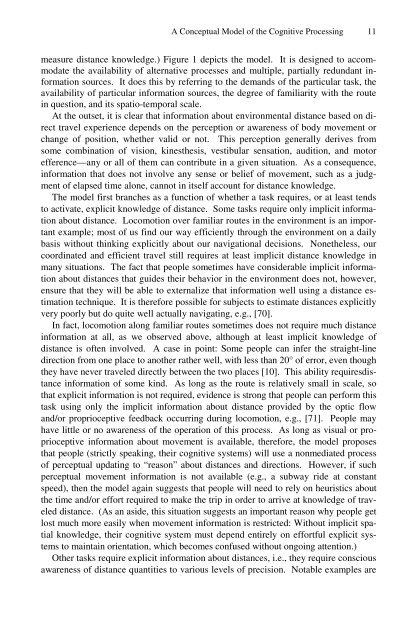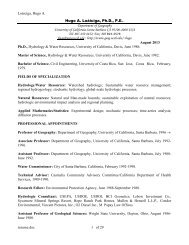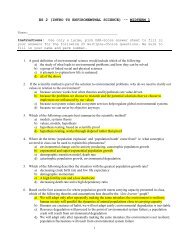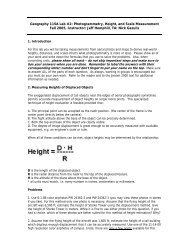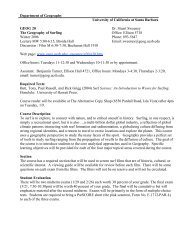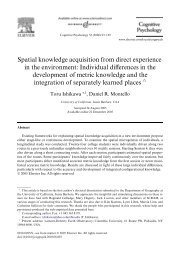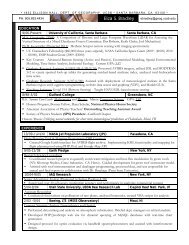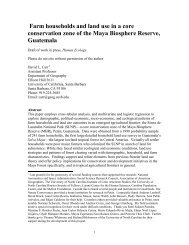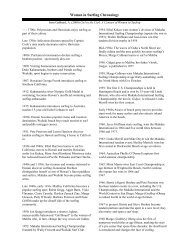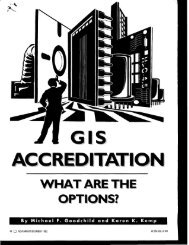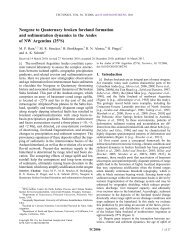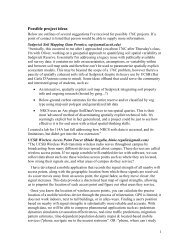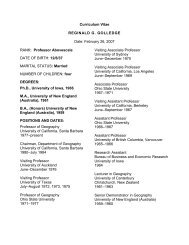A Conceptual Model of the Cognitive Processing of Environmental ...
A Conceptual Model of the Cognitive Processing of Environmental ...
A Conceptual Model of the Cognitive Processing of Environmental ...
You also want an ePaper? Increase the reach of your titles
YUMPU automatically turns print PDFs into web optimized ePapers that Google loves.
A <strong>Conceptual</strong> <strong>Model</strong> <strong>of</strong> <strong>the</strong> <strong>Cognitive</strong> <strong>Processing</strong> 11<br />
measure distance knowledge.) Figure 1 depicts <strong>the</strong> model. It is designed to accommodate<br />
<strong>the</strong> availability <strong>of</strong> alternative processes and multiple, partially redundant information<br />
sources. It does this by referring to <strong>the</strong> demands <strong>of</strong> <strong>the</strong> particular task, <strong>the</strong><br />
availability <strong>of</strong> particular information sources, <strong>the</strong> degree <strong>of</strong> familiarity with <strong>the</strong> route<br />
in question, and its spatio-temporal scale.<br />
At <strong>the</strong> outset, it is clear that information about environmental distance based on direct<br />
travel experience depends on <strong>the</strong> perception or awareness <strong>of</strong> body movement or<br />
change <strong>of</strong> position, whe<strong>the</strong>r valid or not. This perception generally derives from<br />
some combination <strong>of</strong> vision, kines<strong>the</strong>sis, vestibular sensation, audition, and motor<br />
efference—any or all <strong>of</strong> <strong>the</strong>m can contribute in a given situation. As a consequence,<br />
information that does not involve any sense or belief <strong>of</strong> movement, such as a judgment<br />
<strong>of</strong> elapsed time alone, cannot in itself account for distance knowledge.<br />
The model first branches as a function <strong>of</strong> whe<strong>the</strong>r a task requires, or at least tends<br />
to activate, explicit knowledge <strong>of</strong> distance. Some tasks require only implicit information<br />
about distance. Locomotion over familiar routes in <strong>the</strong> environment is an important<br />
example; most <strong>of</strong> us find our way efficiently through <strong>the</strong> environment on a daily<br />
basis without thinking explicitly about our navigational decisions. None<strong>the</strong>less, our<br />
coordinated and efficient travel still requires at least implicit distance knowledge in<br />
many situations. The fact that people sometimes have considerable implicit information<br />
about distances that guides <strong>the</strong>ir behavior in <strong>the</strong> environment does not, however,<br />
ensure that <strong>the</strong>y will be able to externalize that information well using a distance estimation<br />
technique. It is <strong>the</strong>refore possible for subjects to estimate distances explicitly<br />
very poorly but do quite well actually navigating, e.g., [70].<br />
In fact, locomotion along familiar routes sometimes does not require much distance<br />
information at all, as we observed above, although at least implicit knowledge <strong>of</strong><br />
distance is <strong>of</strong>ten involved. A case in point: Some people can infer <strong>the</strong> straight-line<br />
direction from one place to ano<strong>the</strong>r ra<strong>the</strong>r well, with less than 20° <strong>of</strong> error, even though<br />
<strong>the</strong>y have never traveled directly between <strong>the</strong> two places [10]. This ability requiresdistance<br />
information <strong>of</strong> some kind. As long as <strong>the</strong> route is relatively small in scale, so<br />
that explicit information is not required, evidence is strong that people can perform this<br />
task using only <strong>the</strong> implicit information about distance provided by <strong>the</strong> optic flow<br />
and/or proprioceptive feedback occurring during locomotion, e.g., [71]. People may<br />
have little or no awareness <strong>of</strong> <strong>the</strong> operation <strong>of</strong> this process. As long as visual or proprioceptive<br />
information about movement is available, <strong>the</strong>refore, <strong>the</strong> model proposes<br />
that people (strictly speaking, <strong>the</strong>ir cognitive systems) will use a nonmediated process<br />
<strong>of</strong> perceptual updating to “reason” about distances and directions. However, if such<br />
perceptual movement information is not available (e.g., a subway ride at constant<br />
speed), <strong>the</strong>n <strong>the</strong> model again suggests that people will need to rely on heuristics about<br />
<strong>the</strong> time and/or effort required to make <strong>the</strong> trip in order to arrive at knowledge <strong>of</strong> traveled<br />
distance. (As an aside, this situation suggests an important reason why people get<br />
lost much more easily when movement information is restricted: Without implicit spatial<br />
knowledge, <strong>the</strong>ir cognitive system must depend entirely on effortful explicit systems<br />
to maintain orientation, which becomes confused without ongoing attention.)<br />
O<strong>the</strong>r tasks require explicit information about distances, i.e., <strong>the</strong>y require conscious<br />
awareness <strong>of</strong> distance quantities to various levels <strong>of</strong> precision. Notable examples are


